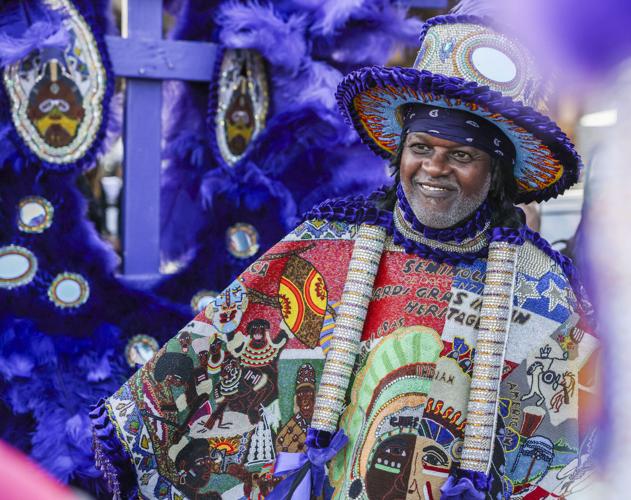The streets of Central City will echo with the rattle of tambourines, shouts of greeting and age-old chants as scores of Black Masking Indians march in the 2024 Uptown Super Sunday procession on March 17.
The day kicks off at noon with Super Sunday Festival in A.L. Davis Park, 2600 Lasalle St., featuring music, food and craft vendors, plus displays and performances. Then, at 2 p.m., the participants assemble and begin their annual trek that returns to the starting point at 4 p.m.

What is a Mardi Gras Indian?
The age-old Black masking tradition symbolizes the interconnection of African and Native American cultures in the history of New Orleans. The members of the more-or-less 70 “tribes” or “gangs” achieve various ranks, including chiefs, queens, wild-men, flags and spy boys. Each has certain roles during appearances.
The maskers create a new suit each year, composed of canvas patches decorated with intricate beadwork depicting wild west or wildlife themes, African symbolism, geometric abstractions and sometimes popular culture. The patches are surrounded by explosions of psychedelically colored feathers. Maskers vie to produce the “prettiest” suits, which are a uniquely New Orleans artform, revered around the world.
Maskers only display their suits a few times each year, on Mardi Gras day, St. Joseph’s night (March 19), at special appearances including the New Orleans Jazz & Heritage Festival and during Super Sunday parades in Central City, Mid-City/Treme and the West Bank. Super Sunday parades are the best time to see the most suits at one event.
As the tribes travel, the maskers and their entourages sing traditional call-and-response chants that have inspired New Orleans' musical styles from rhythm and blues to funk to bounce.
How to describe the age-old phenomenon can be confusing. Participants in the tradition are known as Mardi Gras Indians, Black Masking Indians and sometimes Black Indians. Individuals and groups choose their own terminology. Whatever term you use, witnessing the Super Sunday march is an unforgettable experience.

Mardi Gras Indians parade down S. Claiborne Ave. to A.L. Davis Park on Super Sunday in New Orleans, La. Sunday, March 20, 2022. (Photo by Max Becherer, NOLA.com, The Times-Picayune | The New Orleans Advocate)
What to know, if you go
If you’re driving, be sure to study the map and find a parking spot outside of the “box” to avoid being trapped after the procession passes.
Get there early to sample the street food and beverages and to peruse the suits close up, before the march begins. The incredible detail of the beadwork can sometimes be lost in the flurry of the parade.
The Lasalle Street-Simon Bolivar Avenue side of the route seems more intimate, the North Claiborne Avenue side is more wide open and sunny. It’s rewarding to watch the parade twice in different places, to catch what you missed the first time.
Check back for information about the Downtown and West Banks Super Sunday parades. For more information, visit the New Orleans Mardi Gras Indian Council Facebook page.
Victor Harris, big chief of the Mandingo Warriors, is calling it quits.
Brian Banks has an important role in the Black Flame Hunters Mardi Gras Indian tribe. His job as Gang Flag is to maintain order and help his B…
After 10 months in limbo, the Backstreet Cultural Museum has found a new home. On Saturday, Benny Jones and the Treme Braas Band will lead a s…
The 2025 New Orleans Carnival season starts on Saturday, Jan. 6, and concludes on Mardi Gras, Tuesday, March 4.











